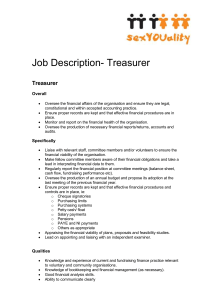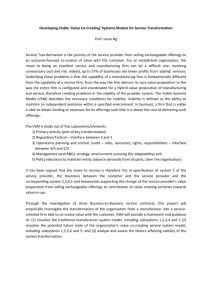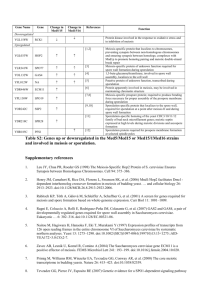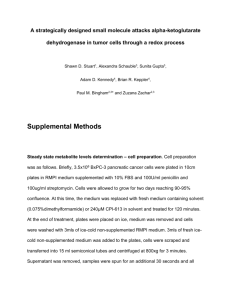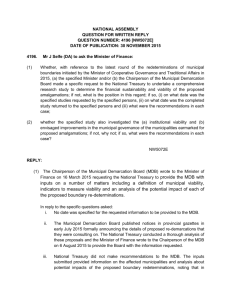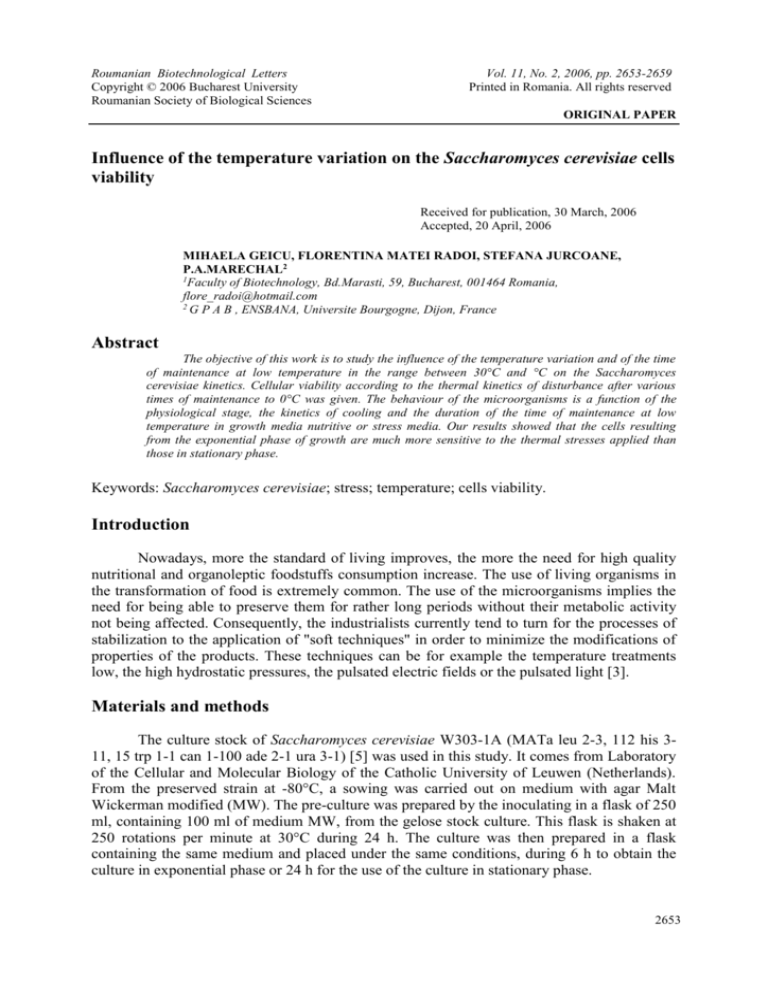
Roumanian Biotechnological Letters
Copyright © 2006 Bucharest University
Roumanian Society of Biological Sciences
Vol. 11, No. 2, 2006, pp. 2653-2659
Printed in Romania. All rights reserved
ORIGINAL PAPER
Influence of the temperature variation on the Saccharomyces cerevisiae cells
viability
Received for publication, 30 March, 2006
Accepted, 20 April, 2006
MIHAELA GEICU, FLORENTINA MATEI RADOI, STEFANA JURCOANE,
P.A.MARECHAL2
1
Faculty of Biotechnology, Bd.Marasti, 59, Bucharest, 001464 Romania,
flore_radoi@hotmail.com
2
G P A B , ENSBANA, Universite Bourgogne, Dijon, France
Abstract
The objective of this work is to study the influence of the temperature variation and of the time
of maintenance at low temperature in the range between 30°C and °C on the Saccharomyces
cerevisiae kinetics. Cellular viability according to the thermal kinetics of disturbance after various
times of maintenance to 0°C was given. The behaviour of the microorganisms is a function of the
physiological stage, the kinetics of cooling and the duration of the time of maintenance at low
temperature in growth media nutritive or stress media. Our results showed that the cells resulting
from the exponential phase of growth are much more sensitive to the thermal stresses applied than
those in stationary phase.
Keywords: Saccharomyces cerevisiae; stress; temperature; cells viability.
Introduction
Nowadays, more the standard of living improves, the more the need for high quality
nutritional and organoleptic foodstuffs consumption increase. The use of living organisms in
the transformation of food is extremely common. The use of the microorganisms implies the
need for being able to preserve them for rather long periods without their metabolic activity
not being affected. Consequently, the industrialists currently tend to turn for the processes of
stabilization to the application of "soft techniques" in order to minimize the modifications of
properties of the products. These techniques can be for example the temperature treatments
low, the high hydrostatic pressures, the pulsated electric fields or the pulsated light [3].
Materials and methods
The culture stock of Saccharomyces cerevisiae W303-1A (MATa leu 2-3, 112 his 311, 15 trp 1-1 can 1-100 ade 2-1 ura 3-1) [5] was used in this study. It comes from Laboratory
of the Cellular and Molecular Biology of the Catholic University of Leuwen (Netherlands).
From the preserved strain at -80°C, a sowing was carried out on medium with agar Malt
Wickerman modified (MW). The pre-culture was prepared by the inoculating in a flask of 250
ml, containing 100 ml of medium MW, from the gelose stock culture. This flask is shaken at
250 rotations per minute at 30°C during 24 h. The culture was then prepared in a flask
containing the same medium and placed under the same conditions, during 6 h to obtain the
culture in exponential phase or 24 h for the use of the culture in stationary phase.
2653
MIHAELA GEICU, FLORENTINA MATEI RADOI, STEFANA JURCOANE, P.A.MARECHAL
Several media were used in this study: medium Malt Wickerham (MW), binary
solution of Water-Glycerol (WG), Water-Glycerol with Glucose (WG+Glu), Water-Glycerol
with pancreatic Peptone (WG+Pep) and Water-Glycerol with yeast extract (WG+YE). The
culture was initially centrifuged with 4000 rotations per minute during 5 minutes and a
temperature of 30°C for Saccharomyces cerevisiae W303-1A.
The supernatant then was removed and replaced by a binary solution of water glycerol
or water-glycerol with glucose, water-glycerol with pancreatic peptone or water-glycerol with
extract yeast. The cellular suspension and the solutions used for the experiments were then
placed during 15 minutes in a bain-marie thermostated in order to reach the desired
temperature.
Two kinetics of cooling (2 and 2000°C.min-1) have been developed like follows:
For the slope, the slowest kinetics (2°C.min-1) was used a cryotube containing 1 ml of
cellular suspension. This cryotube was then placed in a thermostated bain-marie with
30°C for Saccharomyces cerevisiae W303-1A, then a linear and progressive reduction
in temperature of 30°C was obtained thanks to a programmer of temperature.
The shock (2000°C.min-1) was carried out by the fast introduction of 0,1 ml of
cellular suspension from 30°C into 9,9 ml of binary solution (WG, WG+Pep,
WG+Gluc, WG+ YE) of 0°C. For all the experiments, a thermocouple of the type T
was used to follow the kinetics of variation in temperature. After all the heat
treatments, the samples were heated until ambient temperature in order to measure
cellular viability.
The reheating was carried out by putting the samples in a thermostated bain-marie at
30°C (for Saccharomyces cerevisiae W303-1A). This speed of reheating corresponded of a
speed of 20°C.min-1.
In this study, the measurement of cellular viability was determined by the Plate Count
Method on medium with agar on Petri dishes. Each counting of the sample having undergone
the thermal stress was reported to a control not having undergone any variation in the
temperature. The dishes were incubated at the temperature corresponding to the growth
conditions of the microorganisms. Each experiment was repeated at least twice. We used
usual media and selective media in order to determine the effect of the cold stress on the
physiological state of the cells. These mediums would make it possible to determine the
number of wounded cells [4]. Indeed, the wounded cells did not survive on the selective
medium.
The method employed consisted of a NaCl addition in the solid medium. The NaCl
concentration applied was 0,75% in mass for S. cerevisiae. The growth dishes and those with
NaCl were used to determine the number of cells on nonselective medium and selective
medium. The loss of viability is defined by the difference of UFC/mL of microorganisms
between the enumeration of a control and the experimental enumeration on selective and
nonselective medium. The "wounded survivors" are indicated by the difference of UFC/mL
between the control and the samples with micro-organisms stressed on selective medium and
nonselective medium. The measurement of the number of the wounded cells makes it possible
to highlight the non-lethal effect of the thermal stress.
UFCcontrol
% viability = ﴾
﴿ x 100
UFCsample
2654
Roum. Biotechnol. Lett., Vol. 11, No. 2, 2653-2659 (2006)
Influence of the temperature variation on the Saccharomyces cerevisiae cells viability
Results and discussions
The objective of this work was to examine the influence of the kinetics of disturbance
at low temperatures, without freezing, on the viability of the yeast S. cerevisiae. The aim it
was to prove if the resistance at low temperature is a function of the kinetics of variation in
temperature and the stress medium in which we kept the samples during the maintenance time
at low temperatures. The level of survival of the micro-organisms depends in particular on
four parameters: the speed of cooling, the type of microorganism, the phase of growth and
duration of the maintenance time at low temperature. We have noticed that the level of
survival microorganisms also depends on stress medium used.
The figure 1 represents the viability of Saccharomyces cerevisiae W303-1A after a
stress in various media and maintenance times at 30°C during 1 day, 3 days and a week. Two
very different behaviors of the cells from the exponential and stationary phase of growth were
observed. During one week, the control in exponential phase records an important increase,
whereas the cells resulting from the stationary phase of growth record a significant loss.
.
WG
Viability (% scale log)
WG+Gluc
WG+YE
WG+P e p
WG
WG+Gluc
WG+YE
WG+P e p
0
1
2
3
4
5
6
7
8
Tim e (days)
statio nary phase (co ntinuo us line); expo nential phase (do tted line)
Figure 1. Influence of media content during a maintenance time at 30°C (control)
on S.cerevisiae W303-1A growth
The viability of Saccharomyces cerevisiae W303-1A after a cold stress from 30°C to
0°C at a 2°C.min-1 speed, in various media and maintenance times during 1 day, 3 days and a
week is shown in figure 2. We was noticed that after one week the level of cellular viability is
comparable for the exponential phase and the stationary phase of growth.
Roum. Biotechnol. Lett., Vol. 11, No. 2, 2653-2659 (2006)
2655
MIHAELA GEICU, FLORENTINA MATEI RADOI, STEFANA JURCOANE, P.A.MARECHAL
150
WG
.
WG+Gluc
Viability (%)
WG+ED
WG+P ep
WG
100
WG+Gluc
WG+YE
WG+P ep
50
0
1
2
3
Tim e 4(days)
5
6
7
8
stationary phase (continuous line); exponential phase (dotted line)
Figure 2. Influence of the maintenance time at 0°C, after a slope, on S.cerevisiae W303-1A growth; (2°C.min-1
cooling speed )
The viability of Saccharomyces cerevisiae W303-1A after a cold stress of 30°C to 0°C
with a speed of 2000°C.min-1 in various media and maintenance time at 0°C during 1 day, 3
days and a week is shown in Figure 3. Three different behaviors from the cells resulting from
the exponential and stationary phase of growth were observed: an increase in a number of
alive cells if the samples in stationary phase are kept in Water-glycerol medium with peptone
or Water-glycerol with yeast extract, a reduction in viability if the samples in exponential
phase are kept in Water-glycerol medium or Water-glycerol with glucose and a stabilization
for the samples in stationary phase kept in medium Water-glycerol and Water-glycerol with
glucose. We notice same stabilization for the samples in exponential phase of growth kept in
medium Water-glycerol with extract yeast and pancreatic Water-glycerol peptone.
300
250
Viability (%)
.
WG
WG+Gluc
200
WG+YE
WG+Pep
150
WG
WG+Gluc
100
WG+YE
WG+Pep
50
0
0
1
2
3
4
5
6
7
8
Tim e (days)
stationary phase (continuous line); exponential phase (dotted line)
Figure 3. Influence of maintenance time at 0°C, after a shock, in various media on Saccharomyces cerevisiae
W303-1A; (2000°C.min-1 cooling speed)
2656
Roum. Biotechnol. Lett., Vol. 11, No. 2, 2653-2659 (2006)
Influence of the temperature variation on the Saccharomyces cerevisiae cells viability
The kinetics of the temperature variation between 30 and 0°C influence the death of
the microorganisms at the time of cold stress. Two assumptions seem reasonable for the
explanation of cellular mortality after cold thermal stresses:
a modification of the membrane characteristics such as the permeabilisation and
fluidity;
a denaturation of membrane and/or intracellular proteins. Our results showed that the
viability of the cells depends in a drastic way to the speed of application of the thermal
stresses. On one hand, viability is higher when the cells are cooled slowly that
brutally.
Some authors [6] assumed that during the application of a slow cooling, the cells are
likely to develop an adaptive response to the stress which makes them more resistant to
temperatures normally lethal [5]. The synthesis of proteins of stress known as "cold shock
protein" (Csp), trehalose and sterol (only for the case of yeasts) could play a very important
part in the resistance of the cells after a thermal slope. The recent studies showed that sterols
of the membrane of the yeasts which are not synthesized in the bacteria, are a factor making it
possible yeasts to fight against stresses of the environment. It was observed that the viability
of S. cerevisiae after a thermal stress and an ethanol stress increases with the proportion of the
ergosterol in the membrane. The presence of sterols in the membrane of yeasts seems to be
thus a factor of protection of the cells. It is obviously that the effect of the cold stress changes
according to the type of cell, because the microorganisms are quite different on the level from
their physiological and thus from their behavior to the cold stress.
There is a sharp difference in the resistance to the cold thermal stresses between the
exponential phase and the stationary phase of growth. The cells in stationary phase are more
resistant to the stress than the cells in exponential phase. In the exponential phase after a
thermal shock the cells can remain on the same level of viability, for the samples kept in
WG+Pep and WG+YE media, or can go down up to 0%, for the samples kept in medium WG
and WG+Glu media. At the same time the cells resulting from the stationary phase of growth
can remain on the same level of viability, for the samples kept in medium WG and WG+Glu
media, or can go up to 87.1% up to 236.9% for the samples kept in WG+YE medium and of
the 107.1% up to 269.5% for the samples kept in WG+Pep. It should be noted that the cells
are known for a long time to have membrane compositions different according to their phase
from growth. The membranes of the young cells are more fluid, less sterols (only for the case
of yeasts). They are thus more fragile. The fast changes of the environmental parameters thus
seem to disturb these membrane structures. We assume that the more fluid the membrane of
the cell is, the more the cell is sensitive to the disturbance of the temperature.
Following cooling, the integrity of the cells is related to the time of maintenance at
low temperature. Indeed, an important progressive loss of the viability of the surviving cells
appears according to the maintenance time at low temperature, for example in the case of S.
cerevisiae W303-1A in exponential phase of growth after a shock of 30°C to 0°C
(2000°C.min-1) and 7 days maintenance on 0°C in medium WG and WG+Glu, or in
stationary phase of growth after a thermal shock of 30°C to 0°C (2000°C.min-1) and 7 days
maintenance on 0°C in medium WG andWG+Glu. At least two explanations are possible:
the maintained cells at low temperature suffer membrane damage and lose a part of
their material necessary to their survival
the damage and the losses cannot be repaired as long as the temperature is maintained
at a temperature allowing a metabolic activity.
Whatever the speed of cooling, a higher loss of viability appears with the increase of
spent time at reduced temperature. Moreover, more the cells are cooled quickly, plus that
Roum. Biotechnol. Lett., Vol. 11, No. 2, 2653-2659 (2006)
2657
MIHAELA GEICU, FLORENTINA MATEI RADOI, STEFANA JURCOANE, P.A.MARECHAL
involves an important cellular mortality and this whatever the duration of time passes at low
temperature. We can thus think that the first lesions are induced during the phase of cooling
by the speed of disturbance of temperature, but also by the time of maintenance at low
temperature.
These lesions results in either an immediate death, or a death in the course of time if
the cell does not have of capacities to be regenerated. In the case of a shock, we can
distinguish three types of cell whose two types are wounded by the thermal disturbance:
non-wounded resistant cells, the wounded cells which die immediately and the wounded cells
which die during variable times of conservation at low temperature.
In the case of a slope, two types of cells are distinguished: the wounded cells which
die and resistant cells. The part of resistant cells was more important because the thermal
stress in the form of slope was him even less drastic.
On the level of the culture medium, the stationary phase is regarded as a phase of
stress, in particular nutritive and acid, which causes at the cells the installation of active
protection systems enabling him to survive future stresses.
If we look at figure 3, after a shock, we can observe that the samples kept in WG+Pep
and WG+YE media record an increase for the cells resulting from the stationary phase and a
stabilization for the cells resulting from the exponential phase. On the other hand, the samples
kept in WG and WG+Glu media record a loss of viability after one week.
We can think that the source of carbon, which in this case is glucose does not have a
very important role in surviving it of the cells after a cold stress, on the other hand the source
of the proteins, which in case is pancreatic peptone and the extract yeast, plays a very
important part in surviving it and multiplication of the cells.
On the level of their metabolism, trehalose is known for its role of guard in particular
on the levels of three macromolecules of the cell: proteins, the membrane and the ADN. As
the cells in stationary phase have more sugar of reserve than those in exponential phase [2],
the capacity of these cells to preserve their macromolecules at the time of cold stress will be
more important. The protection of proteins, the membrane and the ADN was to play an
important part in the resistance of the cells at the time of the cold stress [1].
Conclusions
In the literature, the temperatures with the top of 0°C are often associated an adaptive
metabolic response of the cells, while the temperatures with the lower part of 0°C do not
allow this type of answer and cell multiplication.
In the range of positive temperatures (30-0°C), our work showed that cellular
resistance during cooling, without presence of freezing, strongly depends on the kinetics of
reduction in temperature. This resistance is one function of the type of cells, the age of cells
and the time of maintenance at low temperature in mediums of stress. The phenomena leading
to the mortality of the microorganisms at the time of variations in temperature are generally
related to membrane modifications or the denaturation of proteins.
We observed that a better safeguarding could be obtained when the process of cooling
is done slowly.
The control of the kinetics of variation in temperature could be applied in
biotechnological treatments so stabilizing food. A better safeguarding could be obtained when
the process of cooling and reheating is done slowly.
Of the same way, the effect of the kinetics of application of such a treatment of
safeguarding could be used in combination with the cumulative effect of a double stress, for
2658
Roum. Biotechnol. Lett., Vol. 11, No. 2, 2653-2659 (2006)
Influence of the temperature variation on the Saccharomyces cerevisiae cells viability
example temperature/pressure of water or hydrostatic temperature/pression, which will
contribute to the development of "soft techniques".
Lastly, since the traditional use into agro-alimentary of the cold is the conservation
and the stabilization of food, this study will allow a new use of the cold, by the weakening
and/or the destruction of the microorganisms in order to stabilize food by associating four
following factors: a low temperature, a speed of cooling rather fast and a time of maintenance
at low temperature sufficiently long in the mediums of stress. This exploitation of the cold
treatments makes it possible to think of the development of new soft technology of
decontamination of food.
Acknowledgments
The author has been financially supported by Leonardo Da Vinci E.U. Programme
(RO/2004/PL93055/S). Special thanks to the laboratories members of G P A B - Laboratoire
de Génie des Procédés Alimentaires et Biotechnologiques, ENSBANA, Dijon, especially to
Dr P.A. Marechal.
References
1.
2.
3.
4.
5.
6.
7.
8.
Beney, L. and Gervais, P. (2001). Influence of the fluidity of the membrane on the
response of microorganisms to environemental stresses. Appl. Microbiol. Biotechnol. 57,
34-42.
Cao Hoang, L. (2004). Influence de la cinétique de la variation de la température entre
35°C et 0°C sur la viabilité cellulaire de microorganismes. DEA de science des aliments,
Université de Bourgogne.
Dumont, F., Marechal, P.A. and Gervais, P. (2003). Influence of cooling rate on
Saccharomyces cerevisiae destruction during freezing: unexpected viability at ultra-rapid
cooling rate. Cryobiology 46, 33-42.
Dumont, F., Marechal, P.A. and Gervais, P. (2004). Cell size and water permeability as
determining factors for cell viability after freezing at different cooling rates. Appl.
Environ. Microbiol. 70, 268-272.
Gervais, P. and Martinez de Marañon, I. (1995). Effect of the kinetics of temperature
variation on Saccharomyces cerevisiae viability and permeability. Biochem. Biophys.
Acta. 1235, 52-56.
Ho, C. (2005). Influence de la cinétique de variation de température de 37°C à 0°C et du
temps de maintien à basse température sur la viabilité des microorganismes, Master
Recherche Science de l’Alimentation, Université de Bourgogne.
Marechal, P.A., Martinez de Marañon, I., Poirrier, I., and Gervais, P. (1999). The
importance of kinetics of application physical stresses on the viability of microorganisms:
significance for minimal food processing. Trends Food Sci. Tech. 10, 15-20.
Morris, G.J. and Clarke, A. (1987). Cell at low temperatures. In The effects of low
temperatures on biological systems, 72-119. Edited by Grout, B.W.W. and Morris, G.J.
Edward Arnold (Publishers) Ltd.
Roum. Biotechnol. Lett., Vol. 11, No. 2, 2653-2659 (2006)
2659



